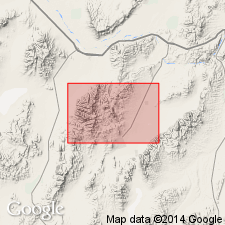
- Usage in publication:
-
- Slaven Chert*
- Modifications:
-
- Named
- Biostratigraphic dating
- Mapped
- Dominant lithology:
-
- Chert
- Shale
- Sandstone
- AAPG geologic province:
-
- Great Basin province
Summary:
Pg. 9 (table 1), 37-42, 138 (fig. 47), pl. 1 (geol. map), pl. 3 (corr. chart), pl. 4 (fossil locs.). Slaven Chert. Present in upper plate of Roberts thrust (siliceous western facies). Consists mostly of black chert, generally in nodular beds 1 to 4 inches thick. Dark carbonaceous shale generally forms partings between the chert layers, but in places makes up beds 4 to 10 feet thick. Limy, sparsely fossiliferous, brown-weathering sandstone beds are present in many exposures. In fault contact with older rocks, thus original relations are unknown. Estimated thickness 2,000+ feet. Authors note that discrimination of Slaven Chert from chert of the Valmy is not certain, thus some bodies assigned to Slaven might be Valmy, and vice versa. Age is considered Middle and Late(?) Devonian, based on fossils (conodonts, ostracodes, radiolarians) collected mostly from the limy sandstones. Report includes geologic map, faunal list, correlation chart.
Named from exposures on hills along and west of Slaven Canyon, in eastern part of T. 30 N., R. 46 E., Lander Co., northern NV.
Source: Publication.
For more information, please contact Nancy Stamm, Geologic Names Committee Secretary.
Asterisk (*) indicates published by U.S. Geological Survey authors.
"No current usage" (†) implies that a name has been abandoned or has fallen into disuse. Former usage and, if known, replacement name given in parentheses ( ).
Slash (/) indicates name conflicts with nomenclatural guidelines (CSN, 1933; ACSN, 1961, 1970; NACSN, 1983, 2005, 2021). May be explained within brackets ([ ]).

